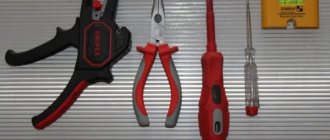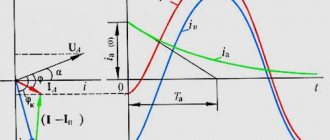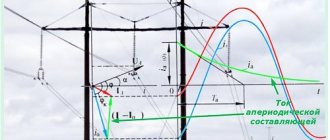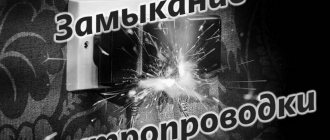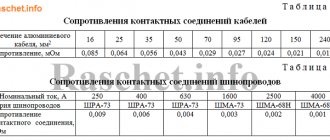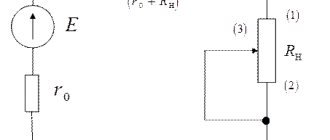Types and reasons
In everyday life, short circuits occur:
- single-phase - when the phase wire is shorted to zero. Such short circuits happen most often;
- two-phase - when one phase is closed to another;
- three-phase - when three phases are closed at once. This is the most problematic type of short circuit.
For example, on Sunday morning, your neighbor behind the wall connects phase and neutral in the socket by plugging in a hammer drill. This means that the circuit is closed and the current flows through the load, that is, through the device plugged into the outlet. If a neighbor connects the phase and neutral wires in the socket without connecting the load, then a short circuit will occur in the circuit, but you will be able to sleep longer.
For those who do not know, for a better understanding it will be useful to read what phase and zero are in electricity. A short circuit is called a short circuit, since the current in such a circuit closure seems to follow a short path, bypassing the load. A controlled or long circuit is the usual, familiar to everyone, plugging in devices into a socket.
An electrical circuit is, as a rule, two conductors with opposite potentials and a connected current consumer. Each end consumer has its own internal resistance, which resists and limits the current, thereby dosing its quantity and density in the conductor, forcing it to produce work.
Nature of the negative phenomenon
To better understand the origin of this phenomenon, you should make a short circuit with your own hands. To do this, you need to assemble a simple electrical circuit from a battery, a light bulb and bare wires. As soon as the power source and the device are connected by wires, current will flow through the circuit and the light bulb will light up. The wires going to the light bulb must be shorted with any metal piece. The current will begin to flow through the new conductor and through the light bulb.
But since the resistance of the wire is very small, all the current will flow through it. In simple terms, a short circuit is the shortest passage of electric current along the path where there is the least resistance in the circuit. The wiring will become very hot, since, according to Ohm's Law from physics, a large current will flow through it. As a result of strong heating, wires may break or catch fire. On a large scale, fires often occur due to this phenomenon.
What is a short circuit
What is called a short circuit (SC)? A short circuit is the connection of current-carrying parts of different phases or potentials to each other or to an equipment body connected to the ground, in power supply networks or in power receivers.
Why does a short circuit (short circuit) occur?
- deterioration of insulation resistance in humid or chemically active environments;
- in case of unacceptable overheating of the insulation;
- mechanical influences;
- erroneous impacts of personnel during maintenance and repair, etc.
The table below shows the maximum permissible load on various devices and devices:
As can be seen from the very name of the process, during a short circuit the current path is shortened, i.e., it goes bypassing the load resistance, so it can increase to unacceptable values if the voltage is not turned off under the influence of electrical protection. But the voltage may not turn off even if there is protection, if a short circuit occurs at a remote point, and due to the high resistance to the short circuit, the current is insufficient to trigger the protection. But this current may be sufficient to ignite the wires, which can lead to a fire.
Short circuit in the city trolleybus network
What to do if it shorts: emergency actions
If there is a power outage in your home, you should make sure that there is an emergency at home.
Smoke and the acrid smell of melted plastic will tell you about problems. It is necessary to turn off the machines, unscrew the plugs on the electrical panel, and disconnect electrical appliances from the sockets. It is better to put out an open fire by covering it with a blanket or thick cloth.
If you have a powder (car) or carbon dioxide fire extinguisher, be sure to use it to extinguish the fire. Do not pour water on the fire!
The causes of serious electrical faults are varied, but in most cases are known. The occurrence of a short circuit is associated with improper operation and violation of clause 2.1.21 of the PEU rules during installation of electrical wiring.
Short circuit currents: accurate calculation required
Hence the need arises to calculate the short-circuit current - short-circuit current. The magnitude of short-circuit currents may change if other electrical receivers in more remote locations are connected to the power supply network of your home. In such cases, the short-circuit current is calculated again at the installation site of new electrical receivers. Short-circuit currents also produce an electrodynamic effect on devices and conductors, when their parts can be deformed under the influence of mechanical forces that arise at high currents.
In the event of a short circuit, overheating of devices and wires occurs. The thermal effect of short-circuit currents is the overheating of devices and wires. Therefore, when choosing devices, they need to be checked for short-circuit conditions so that they can withstand short-circuit currents at the place of their installation. As is known, along with networks with a solidly grounded neutral, there are networks with an isolated neutral. Let us consider the characteristic differences of these networks during a short circuit.
This is interesting! All about semiconductor diodes.
How to fix
Replacing an outlet after a short circuit
When a place is found where the wiring is shorted, it needs to be replaced and repaired. First, you need to de-energize the room and only then change the problem area. The junction of two conductors must be reliably insulated. It is also important to choose the right way to create a contact. If a switch or socket burns out due to a short circuit current, it is recommended to purchase and install a new product. It is cheaper and more reliable than repairing a broken device.
In older houses, electrical wiring was made of aluminum. This is an unreliable outdated method of laying networks, so it needs to be completely replaced. It is the aluminum wiring that can short out.
When a household appliance shorts out, it should be repaired by a professional. Repairing a device yourself without professional tools, skills and abilities is dangerous to your health.
Single-phase short circuits
In practice, single-phase short circuits occur in most cases. In networks with an isolated neutral, when one phase is connected to ground, the mode is not a short circuit and the uninterrupted power supply is not disrupted, but it must be turned off, since it corresponds to an emergency condition. When one phase is short-circuited to ground in a given network, the voltages on the other two phases increase by 1.73 times, and the voltage at the zero point becomes equal to the phase voltage relative to ground.
It will be interesting➡ What is the coefficient of performance (efficiency) and how to calculate it using the formula
In networks with a solidly grounded neutral, when the wire is connected to the ground, a fuse burns or a circuit breaker trips, which disrupts the power supply, and if the fuse burns, the motor windings can be damaged when operating on two phases.
If in any part of the electrical wiring or electrical appliance (light bulb, iron, etc.) the insulation is broken and the phase wire touches the neutral wire, a short circuit will occur.
Since there is no load between the shorted wires, in other words, the electrical resistance of the contact point is practically zero, the current through the contact will begin to increase until the wires melt, which, in particular, can lead to a fire. Fuses are used to protect against short circuits.
A simple (in the form of a “plug”) fuse is a low-fusible insert included in the phase wire, which, when the current increases, will burn out and open the circuit long before more serious troubles occur. Structurally, the fuse is designed in such a way that this micro-disaster does not lead to damage to the fuse block. The little heroine who sacrificed herself is thrown out and replaced by the next one.
How to find a short circuit in wiring
As a rule, the search for a short circuit occurs after the plugs or circuit breaker have been knocked out.
There are several options here:
- visual inspection;
- use of special devices;
- exception;
- by sound;
- by smell.
External inspection during short circuit
If you find that the insulation is damaged or the contact of two exposed wires is damaged, you can assume that the cause has been found.
Typically, such damage can be found in junction boxes, switches or sockets where wires are connected.
If you notice a burnt shell, this is a malfunction.
How to find short circuits using instruments
It is better to use a megohmmeter or multi-meter for this. They will quickly check the resistance in the circuit.
Connect one wire of the device to the phase and the other to ground (to zero).
If the device shows zero, the wiring is normal. Anything above zero indicates contact contact.
It is worth considering that the multimeter has a small resistance, so it is not always possible to determine a short circuit with its help.
How to find a closure using the elimination method
Everything is simple here, but the method is effective in case of fault of the electrical appliance.
When your breaker is knocked out, turn off all electrical power.
Then turn on the machine and start connecting each of the devices.
How to find a short circuit by sound and smell
When the contacts close, you can hear a crackling sound. The main thing is to have good hearing. By the smell of burning plastic and light smoke, you can easily find a broken wiring in the house.
Short circuit protection
As we found out, short-circuit currents are very dangerous, primarily from the point of view of fire safety. Therefore, it is necessary to build protection against short-circuit currents, that is, install circuit breakers in the switchboard. Automatic fuses are designed so that in the event of a short circuit, an increase in the short-circuit current leads to the operation of an instantaneous electromagnetic release, which disconnects the electrical circuit without harming itself.
In order to turn on the electricity again after eliminating the short circuit, you just need to press the white button (the red one is used to turn it off) or flip up the lever that dropped when the fuse was activated.
The rules for installing electrical wiring provide for the calculation of the load and currents passing through the circuit breakers. It is clear that the fuse must operate at current values selected with a significant margin. Otherwise, random small fluctuations in the voltage in the network (and therefore the current) will lead to constant false operation of the protection. On the other hand, the margin should not be too large so that the action of the current does not cause harm to the network before the cutoff occurs.
Cable insulation fire.
Automatic fuse protects internal and external networks
Note that automatic fuses installed at the beginning of each house line (working group) protect not only the house network, but also the external one, from short circuits. In fact, if they were not there, then an emergency short circuit would lead to the failure of the transformer substation, or rather, the electrical power panel of a higher level, so that a significant number of users would lose electricity, and even without calling the emergency service there would be not enough. And if you have a “machine”, it is enough to turn it on after operation (removing, of course, the cause of the short circuit).
The need for several lines in the house also becomes clear: if one line fails, there are others in stock. By the way, here is the conclusion: it is convenient if each work group supplies power to an emergency light bulb in the area of the meter or an emergency socket into which a portable lamp can be plugged in.
Prevention of short circuits
Taking preventive actions is safer, more reliable and cheaper than restoring wiring after a short circuit. Sockets need to be checked periodically. If they start to spark, they need to be repaired or replaced. If the wiring has been partially replaced, the reliability of the connection points and the integrity of the insulating layer should be checked.
Light sources, lighting network and power cables should be checked every few months. A short circuit may occur over time. It can be detected by changes in the color of devices or their melting. The apartment must have automatic switches. Powerful electrical appliances are equipped with separate protective equipment that should operate in an emergency.
When installing electrical wiring yourself, it is important to correctly calculate the cable cross-section. If it is not able to withstand the power of all connected devices, an overload will occur, leading to a short circuit. Cables should not be laid closely together - this may damage the protective layer. Also, when connecting, you need to choose the right way to create a contact and purchase the necessary equipment in advance. Do not connect wires by twisting.
If you need to drill into a wall, you should check the place with a homemade metal detector or study the electrical wiring diagram. This way you can detect a hidden wiring cable that a technician could accidentally damage.
What are the types
Short circuit. Everyone has heard this phrase. Many have seen the inscription “Do not short-circuit!” Often, when an electrical appliance breaks down, they say: “It’s short!” And despite the negative connotation of these words, professionals know that a short circuit is not a sad death sentence. Sometimes it is pointless to fight a short circuit (SC), and sometimes it is fundamentally impossible. This article will answer the most important questions: what is a short circuit and what types of short circuits are found in technology.
It will be interesting➡ What is electrical resistance
Let's begin to look at these issues from an unusual angle - we will find out in which cases short circuits are inevitable and where they do not play the role of damage. Let's take an ordinary metal wire at both ends. Let's connect the ends together. The wire is short-circuited - a short circuit has occurred. But since there are no sources of electrical energy or load in the circuit, such a short circuit does not cause any harm. In some areas of electrical engineering, the short circuit that we have considered plays into our hands, for example, in electrical devices and electrical machines.
Related material: How to connect a capacitor
Let's take a look at a single-phase relay or starter, the design of which includes a magnetic system with moving parts - an electromagnet that attracts an armature. Due to the constantly changing polarity of the current flowing in the windings of the electromagnet, its magnetic flux periodically becomes zero, which causes the armature to rattle, vibrations and a characteristic hum, familiar to all electricians, appear. To get rid of this phenomenon, a short-circuited turn - a ring or rectangle made of copper or aluminum - is attached to the end of the electromagnet core or armature.
Due to the phenomenon of electromagnetic induction, a current is created in the coil, creating its own magnetic flux, compensating for the loss of the main magnetic flux created by the electromagnet, which leads to a decrease or disappearance of vibrations that destroy the structure.
A short circuit in the rotor of an asynchronous electric motor also plays a role. Due to the interaction of the magnetic field created by the stator windings with the squirrel-cage rotor, according to the already mentioned law, currents appear in the rotor, creating their own field, which causes the rotor to rotate. Of course, it is important to properly design an electric motor or electrical apparatus so that the currents flowing in short-circuited elements do not lead to overheating and damage to the insulation of the main windings.
Socket fire
Similarly, the concept of "short circuit" is used in relation to transformers. People who are in one way or another connected with the energy industry know that one of the most important characteristics of a transformer is the short-circuit voltage, VSC, measured as a percentage. Let's take a transformer. We short-circuit one of its windings, say, low voltage (LV), with an ammeter, the resistance of which, as is known, is taken equal to zero. We connect the high voltage winding (HV) to a voltage source. We increase the voltage on the HV winding until the current in the LV winding becomes equal to the rated one, and fix this voltage.
We divide it by the rated voltage of the higher side, multiply by 100%, and get USC. This value characterizes the power loss in the transformer and its resistance, which determines the short circuit current leading to damage. Let's finally talk about short circuits that have negative consequences. Such short circuits occur when current from the power source does not flow through the load, but only through wires that have negligible resistance. For example, a three-phase cable is powered by a transformer, and with one careless movement of the excavator bucket it is damaged - two phases are short-circuited through the bucket. Such a short circuit is called two-phase. Other short circuits are called similarly based on the number of closed phases.
A single-phase earth fault in networks with an isolated neutral is not short, but can pose a threat to the lives of living beings. A short circuit in which the transition resistance is zero is called metallic - for example, with a bolted or welded connection. Short-circuit currents, depending on the voltage and type of damage, can reach thousands and hundreds of thousands of amperes, leading to fires and colossal electrodynamic forces that “twist” tires and wires. Protection against short circuits can be carried out by circuit breakers or fuses, and in high-voltage networks - by means of relay protection and automation.
Protection of the power supply from short circuit.
Characteristic signs and consequences
Visually, such a process can be identified by bright flashes, the appearance of smoke, charred wires and blown fuses. In addition, this causes a voltage drop and an increase in current in the electrical line. All these phenomena pose a great danger, namely:
- At the point of contact between conductors or device elements, a source of ignition appears, which often leads to a fire.
- A drop in voltage causes electrical equipment and household appliances to malfunction.
- Electromagnetic waves arise that affect communication lines and communications.
- A chain of various accidents occurs, leading to disconnection of consumers from the energy system until the consequences are eliminated.
You might be interested in: Design, principle of operation and application of an ionistor
The consequences of a negative phenomenon are considered very serious, therefore, when designing and installing electrical equipment, short-circuit protection must be installed.
How does a short circuit differ from an overload?
If the phase and neutral of the electrical network are connected under voltage to each other not through the consumer, but directly, then a short circuit will occur, abbreviated as short circuit. A short circuit is the connection of conductors of individual phases to each other or to the ground through a relatively low resistance, taken equal to zero in the case of a solid metal short circuit.
No network is designed to operate in this mode for long periods of time. However, this emergency mode sometimes occurs. Thus, a short circuit can occur due to a violation of the insulation of the electrical wiring or due to the accidental short circuit of opposite conductors with conductive parts of electrical equipment. The normal operation of the electrical network will be disrupted. To prevent this undesirable phenomenon, electricians use terminal blocks or simply isolate the connections.
It will be interesting➡ What is a Faraday cage
The problem with the short circuit mode is that at the moment of its occurrence, the current in the network increases many times (up to 20 times the nominal), which leads to the release of a huge amount of Joule heat (up to 400 times the norm), since the amount of heat released is proportional to the square of the current and resistance consumer.
Now imagine: the consumer resistance here is a fraction of an ohm of the wiring, and the current, as is known, the higher the lower the resistance. As a result, if the protective device does not immediately operate, excessive overheating of the wiring will occur, the wires will melt, the insulation will ignite, and a fire may occur in the room. In neighboring rooms supplied by the same network, the voltage will drop, and some electrical appliances may fail.
Important on the topic: How to ring a transistor.
A typical type of short circuit for residential apartments is a single-phase short circuit, when a phase closes to zero. For three-phase networks, for example in a workshop or garage, a three-phase or two-phase short circuit is possible (two phases between each other, three phases between each other, or several phases to zero). Three-phase equipment, such as an asynchronous motor or a three-phase transformer, is characterized by an interturn short circuit, when the turns are short-circuited inside the stator winding or inside the transformer winding, shunting the remaining working turns and thus disabling the device.
Or a short circuit may occur through the conductive body of the device. In general, conductive housings should be grounded in order to protect personnel from accidental electric shock, and wires in apartments should be those with non-flammable insulation. There is another type of emergency load mode of the electrical network associated with excess of normal current.
This is the so-called overload. Overloads sometimes occur in apartments, houses, and businesses. This is a dangerous mode, sometimes more dangerous than a short circuit. After all, a short circuit in an apartment can be stopped in the bud by an instantly triggered circuit breaker in the panel. But current overload is a more tricky case.
Switches for short circuit protection.
Imagine that you decided to plug a lot of electrical appliances into one single outlet through a tee and extension cords. What undesirable things could happen in this case? If the wiring core connected to the outlet is not designed for a current of more than 16 amperes, then when a load of more than 3500 watts is connected to such an outlet, overheating of the electrical wiring will begin, fraught with fire.
In general, the thermal effect on wire insulation sharply reduces its mechanical and dielectric properties. For example, if the conductivity of electrical cardboard (as an insulating material) at 20°C is taken as unity, then at temperatures of 30, 40 and 50°C it will increase by 4, 13 and 37 times, respectively.
And thermal aging of insulation most often occurs precisely because of overload of electrical networks with currents exceeding the long-term permissible for a given type and cross-section of conductors. It is also impossible to connect consumers of more than 2500 W to a socket on which 250 V 10 A is indicated, because the contacts may begin to overheat, leading to their accelerated oxidation. To protect against overloads in the apartment, as well as to instantly stop the short circuit mode, use circuit breakers.
Protection methods
Since the occurrence of this phenomenon cannot be completely excluded, therefore all protective measures are based on the prevention and prevention of short circuits. The main task is to apply measures that reduce the likelihood of an emergency. These include:
- Monitoring the condition of insulating material on live elements or electrical transmission lines. Once every three years, tests are carried out on the insulation of electrical wires in industrial premises, and in household highways, its reliability is determined according to its service life. For copper wire it is 40 years.
- Before carrying out repair work related to drilling walls, it is necessary to determine the location of hidden wires using a special device.
- Avoid or minimize the use of electrical equipment in the bathroom and other areas with high humidity.
To ensure the safety of electrical equipment, automatic switches are installed both at the input and on each internal line. The switch is triggered when a large current flows through it, which is formed as a result of a short circuit in the electrical network or household appliance.
Some switchgear uses fuses that are rated for a specific amperage. In production, to protect electric motors, a special relay is installed, which breaks the circuit when the armature or stator winding of the device is closed.
Suddenness
The types of short circuits are completely different from each other. A sudden and deep decrease in voltage is especially hard, which immediately affects the end users of the power grid. The most ordinary engines have a particularly difficult time withstand jumps. They sometimes stop even after the jumps do not exceed 30 - 40 percent of the norm.
This is called rollover. After this, an entire industrial enterprise or plant may shut down, which will ultimately lead to multimillion-dollar costs. The recovery phase will also take time. This situation can damage some production elements, which will ultimately lead to rejected products and even greater losses.
What to do with short circuits if they are located at a short distance and last a long time? It all depends on the specific situation. If two stations operate synchronously in parallel, then after an incident this operation is disrupted. The sequence of all processes changes, the entire electrical system ceases to function correctly. This is the most dangerous type.
If a short circuit occurs to the ground, then the current can already be dangerous for everyone who is in the immediate vicinity, and for electrical appliances, of course.
The consequences are always dire:
- Damage to mechanical and thermal properties;
- The occurrence of a fire;
- Reduced voltage (inhibition of processes, deterioration in performance);
- Desynchronization of generators, substations and the entire system, leading to emergencies on a global scale;
- Electromagnetic influence on communication devices.
